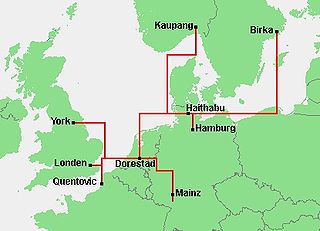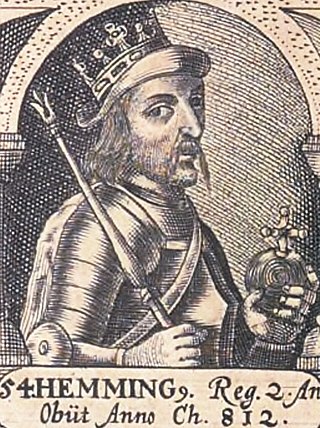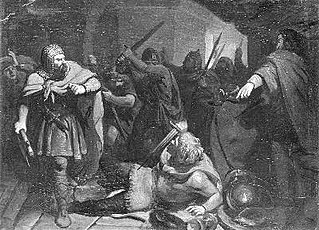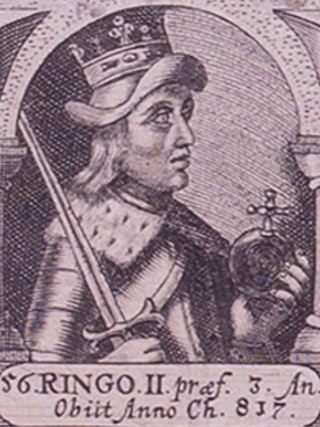
Dorestad was an early medieval emporium, located in the southeast of the province of Utrecht in the Netherlands, close to the modern-day town of Wijk bij Duurstede. It flourished during the 8th to early 9th centuries, as an important port on the northeastern shipping routes due to its proximity to the fork in the Rhine, with access to Germany via the Nederrijn, to the southern Netherlands, northern France, and England, and to the northern Netherlands, northern Germany, and Scandinavia.

Danegeld was a tax raised to pay tribute or protection money to the Viking raiders to save a land from being ravaged. It was called the geld or gafol in eleventh-century sources. It was characteristic of royal policy in both England and Francia during the ninth through eleventh centuries, collected both as tributary, to buy off the attackers, and as stipendiary, to pay the defensive forces. The term danegeld did not appear until the late eleventh century. In Anglo-Saxon England tribute payments to the Danes was known as gafol and the levy raised to support the standing army, for the defence of the realm, was known as heregeld (army-tax).

Hemming I was a king in Denmark from 810 until his death. He was the successor of King Gudfred, his uncle.

Bruno, also called Brun or Braun, a member of the Ottonian dynasty, was Duke of Saxony from 866 until his death. He is rated as an ancestor of the Brunonids, a cadet branch of the Ottonians, though an affiliation is uncertain. Bruno was killed fighting against Norse warriors in the Battle of Lüneburg Heath and is venerated as one of the Ebsdorf Martyrs.

Rorik was a Danish Viking, who ruled over parts of Friesland between 841 and 873, conquering Dorestad and Utrecht in 850. Rorik swore allegiance to Louis the German in 873. He was born in Denmark around 800. He died at some point between 873 and 882.

Godfrid, Godafrid, Gudfrid, or Gottfrid was a Danish Viking leader of the late ninth century. He had probably been with the Great Heathen Army, descended on the continent, and became a vassal of the emperor Charles the Fat, controlling most of Frisia between 882 and 885.
Harald 'Klak' Halfdansson was a king in Jutland around 812–814 and again from 819–827.
Hemming may refer to:
Henry was the leading military commander of the last years of the Carolingian Empire. He was commander-in-chief under Kings Louis the Younger and Charles the Fat. His early career was mostly restricted to East Francia, his homeland, but after Charles inherited West Francia in 884 he was increasingly active there. During his time, raids by the Vikings peaked in Francia. The sources describe at least eight separate campaigns waged by Henry against the Vikings, most of them successful.
Baldric or Balderic (Bald[e]ricus) was the Duke of Friuli from 819, when he replaced Cadolah according to Thegan of Trier in his Vita Hludowici imperatoris, until 828, when he was removed from office: the last Duke of Friuli.

Horik I or Hårik was a king of the Danes. He was co-ruler from 813, and sole king from c. 828 until his violent death in 854. His long and eventful reign was marked by Danish raids on the Carolingian Empire of Louis the Pious, son and successor of Charlemagne.
Godfrid Haraldsson was the son of the Danish king Harald Klak. In 826 he was baptized together with his parents in Mainz in the Frankish Empire, with crown prince Lothair standing as a godparent.

Horik II, also known as Hårik or, in late sources, Erik Barn, was King of the Danes from the fall of Horik I in 854 to an unknown date between 864 and 873. During his reign the Danish kingdom showed tendencies of breaking up. After his demise under unknown circumstances, Denmark entered a long period of obscurity, until the rise of the Jelling dynasty in the 10th century.
A Dane named Hemming was a count in the area of Rüstringen in East Frisia in the 9th century. He and some others of his family were installed in this region by Emperor Lothair I.
Halfdan was a leading person among the Danes and the first known Scandinavian to enter Frankish service. Onomastics links him to the Danish royal family since the name "Halfdan" was commonly employed both historically and in the legendary royal lineage.
Reginfrid was a co-King of Denmark from 812, when Hemming I died, to 813, when he and his brothers were ousted by the sons of a previous king, Gudfred. He was probably a son of Halfdan, a Danish leader who became a vassal of Charlemagne in 807, and brother of Anulo, Hemming, and Harald Klak. He was probably also related to the Danish king he succeeded.
Bjørn was a Viking chieftain. He is the earliest known Scandinavian who was not a relative of the Danish kings to enter the service of a Frankish king, in his case Charles the Bald, king of West Francia. He may be identified with the Swedish king Björn Ironside.

Anulo or Ale was a pretender-king who vied for the Danish throne in 812. He represents the appearance of the House of Harald which competed with the House of Gudfred for power in Denmark until c. 857 and possibly longer.